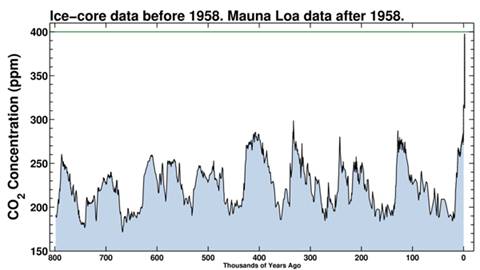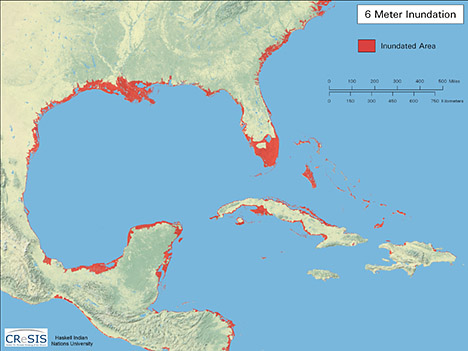
World Passes 400 PPM
Carbon Dioxide Level Milestone;
Experts Say 'We're Stuck' With
Global Warming
WASHINGTON - Associated Press, May 10, 2013
 The old saying
that "what goes up must come down" doesn't apply to carbon dioxide
pollution in the air, which just hit an unnerving milestone. The old saying
that "what goes up must come down" doesn't apply to carbon dioxide
pollution in the air, which just hit an unnerving milestone.
The chief greenhouse gas was measured Thursday
at 400ppm (parts per million) in Hawaii, a monitoring site that sets
the world's benchmark. It's a symbolic mark that scientists and
environmentalists have been anticipating for years.
While this week's number has garnered
all sorts of attention, it is just a daily reading in the month when the chief
greenhouse gas peaks in the Northern Hemisphere. It will be lower the rest of
the year. This year will probably average around 396ppm. But not for long — the
trend is going up and at faster and faster rates.
Within a decade the world will never see
days — even in the cleanest of places on days in the fall when greenhouse gases
are at their lowest — when the carbon measurement falls below 400ppm, said
James Butler, director of global monitoring at the National Oceanic and
Atmospheric Administration's Earth Science Research Lab in Boulder, Colo.
"The 400 level is a reminder that our
emissions are not only continuing, but they're accelerating; that's a scary
thing," Butler said Saturday. "We're stuck. We're going to keep going up."
Carbon dioxide stays in the air for a
century, some of it into the thousands of years. And the world carbon dioxide
pollution levels are accelerating yearly. Every second, the world's smokestacks
and cars pump 2.4 million pounds of the heat-trapping gas into the air. Carbon
pollution levels that used to be normal for the 20th century are fast becoming
history in the 21st century.
"It means we are essentially passing one
in a whole series of points of no return," said Michael Mann, a climate
scientist at Pennsylvania State University.
Princeton University climate scientist
Michael Oppenheimer said the momentum in carbon dioxide emissions has the world
heading toward and passing 450ppm. That is the level which would essentially
mean the world warms another 2 degrees centigrade, what scientists think of as
dangerous, he said. That 2°C mark is what much of the world's
nations have set as a goal to prevent.
"The direction we've seen is for blowing
through the best benchmark for what's dangerous change," Oppenheimer
said.
And to see what the future is,
scientists look to the past. The last time the worldwide carbon level
probably hit 400ppm was about 2 million years ago, said Pieter Tans of the
National Oceanic and Atmospheric Administration.
 Severe Coastal Inundation around Caribbean with 20 ft.
sea rise Severe Coastal Inundation around Caribbean with 20 ft.
sea rise
 That was during
the Pleistocene Era. "It was much warmer than it is today," Tans said. "There
were forests in Greenland. Sea level was higher, between 10 and 20 meters (33
to 66 feet)." That was during
the Pleistocene Era. "It was much warmer than it is today," Tans said. "There
were forests in Greenland. Sea level was higher, between 10 and 20 meters (33
to 66 feet)."
Other scientists say it may have been 10
million years ago that Earth last encountered this much carbon dioxide in the
atmosphere. The first modern humans only appeared in Africa about 200,000 years
ago.
Environmental activists, such as former
Vice President Al Gore, seized on the milestone.
"This number is a reminder that for the
last 150 years — and especially over the last several decades — we have been
recklessly polluting the protective sheath of atmosphere that surrounds the
Earth and protects the conditions that have fostered the flourishing of our
civilization," Gore said in a statement. "We are altering the composition of our atmosphere
at an unprecedented rate."
Carbon dioxide traps heat just like in a
greenhouse. It accounts for three-quarters of the planet's heat-trapping gases.
There are others, such as methane, which has a shorter life span but traps heat
more effectively. Both trigger temperatures to rise over time, scientists say,
which is causing sea levels to rise and some weather patterns to change.
When measurements of carbon dioxide were
first taken in 1958, it measured 315ppm. Some scientists and environmental
groups promote 350ppm as a safe level for CO2, but scientists acknowledge they
don't really know what levels would stop the effects of global warming.
The level of carbon dioxide in the air
is rising faster than in the past decades, despite international efforts by
developed nations to curb it. On average the amount is growing by about 2ppm
per year. That's 100 times faster than at the end of the Ice Age.
Back then, it took 7,000 years for
carbon dioxide to reach 80ppm, Tans said. Because of the burning of fossil
fuels, such as oil and coal, carbon dioxide levels have gone up by that amount
in just 55 years.
|
